The Electronic Intifada 6 November 2014
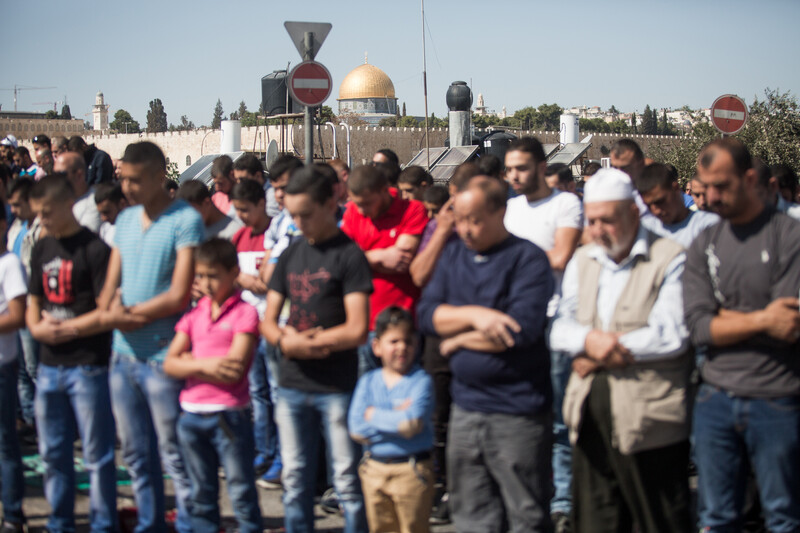
Palestinians hold Friday prayers in the Jerusalem neighborhood of Ras al-Amoud on 24 October due to Israeli restrictions on access to the al-Aqsa mosque imposed on Palestinians.
ActiveStillsViolence flared in Jerusalem during the month of October as Israel restricted Palestinian access to the al-Aqsa mosque compound and repressed protests against those restrictions.
Israeli police in Jerusalem shot and killed two Palestinians in what may amount to extrajudicial executions.
Thirty-two-year-old Palestinian Mutaz Hijazi was shot and killed after a raid on his home on 30 October. Israel named Hijazi as a suspect in the attempted assassination of Yehuda Glick, an American-born settler who leads a movement which seeks the replacement of the al-Aqsa mosque and Dome of the Rock with a Jewish “Third Temple.” Glick was shot and seriously wounded on 29 October.
The previous week, Abd al-Rahman al-Shaludi, a thirty-year-old Palestinian man from the Silwan neighborhood of eastern occupied Jerusalem, was shot and soon died of his wounds on 22 October after his car ran into a light rail station, “killing an Israeli infant and injuring eight others, including an Israeli woman who later died of her wounds,” according to the United Nations monitoring group OCHA.
Children slain
Elsewhere in the occupied West Bank, Orwa Hammad, a fourteen-year-old Palestinian child who carries US citizenship, was shot in the neck with live fire and killed by Israeli forces in the Ramallah-area village of Silwad on 24 October.
Another boy was shot and killed by Israeli forces using live ammunition in Beit Liqya village near Ramallah on 16 October. Residents and eyewitnesses said that thirteen-year-old Bahaa Samir Badir was returning home from the village’s playground and was not involved in confrontations with Israeli forces when he was shot.
Forty-five Palestinians, including twelve children, were killed by Israeli forces in the West Bank since the beginning of the year through 27 October, according to OCHA. Twenty-six Palestinians, including four children, were killed in the West Bank by the military in the whole of 2013.
Another child was killed in the West Bank this month after she was hit by an Israeli motorist traveling on Road 60 near the Ramallah-area village of Sinjil. Five-year-old Inas Shawkat Khalil died of her wounds and another girl, six years old, remains seriously injured. “Since the beginning of the year fourteen similar incidents were reported, the majority of which occurred in the Hebron governorate,” states OCHA.
Gaza death toll rises
Meanwhile in Gaza, victims of Israel’s summer assault died of their wounds and the body of another was pulled from the rubble of a destroyed mosque, bringing the cumulative death toll among Palestinians killed during the 51 days of violence to 2,194, including 519 children.
A four-year-old child was killed in the northern Gaza town of Beit Hanoun on 22 October when unexploded ordnance detonated. Five Palestinians have been killed by unexploded ordnance and six others injured since the 26 August ceasefire, according to OCHA.
No rocket fire was reported from Gaza from the beginning of the month through 27 October; Israeli forces continued to fire on and injure fishermen and farmers there.
Siege and displacement
The ministry of health in Gaza warned of a humanitarian crisis in the territory’s hospitals due to the chronic deficiency in electricity supply and lack of fuel to power back-up generators. Israel bombed Gaza’s sole power plant during its summer assault and though the plant was repaired, it has remained shut down due to lack of fuel, resulting in power outages in the Gaza Strip of up to eighteen hours per day.
On 14 October the first shipment of two tons of basic construction materials for the private sector was allowed to enter Gaza via Israel’s Kerem Shalom checkpoint. Israel has severely restricted the importation of construction materials since 2007; last month’s delivery was the first shipment allowed by Israel since 13 October 2013, according to OCHA.
UNRWA, the UN agency for Palestine refugees, stated on 30 October that 18 of its schools are still being used as shelters for 32,419 Palestinians displaced during the summer assault. The agency added that “at least 80 percent of the 100,000 Palestinian homes damaged or destroyed were refugee homes.”
Syria
Meanwhile, half of the 540,000 Palestinian refugees registered with UNRWA in Syria are internally displaced in the war-torn country, with more than 70,000 others displaced to other countries, most of them in Lebanon and Jordan, according to the agency. UNRWA installations across Syria were housing more than six thousand internally displaced persons, of whom nine percent were Syrians, as of 16 October.
UNRWA reported a “significant decline” since July in the amount of food and humanitarian aid the agency is allowed to distribute in Yarmouk refugee camp near Damascus, where 18,000 civilians live under siege.
The agency’s commissioner-general warned that in Syria, “We may be witnessing the beginning of a second long-term refugee community in the Middle East,” the first being the Palestinians who have been subjected to waves of forced migration since 1948. The UN refugee agency UNHCR estimates that 3.2 million Syrians have fled to neighboring countries and North Africa.

The father of fourteen-year-old Orwa Hammad mourns during his son’s funeral in the West Bank village of Silwad on 26 October. Israeli soldiers shot and killed Hammad, an American citizen, during clashes in his village on 24 October.
ActiveStills
Palestinian Authority Prime Minister Rami Hamdallah is welcomed upon his arrival to the Gaza Strip on 9 October. Hamdallah said that the unity government under his charge will rebuild the bombed-out Gaza Strip.
APA images
Homes destroyed during Israel’s seven-week assault in the Shujaiya neighborhood east of Gaza City, photographed on 12 October ahead of a donor conference in Cairo where $5.4 billion was pledged to rebuild Gaza.
ActiveStills
Palestinian Authority leader Mahmoud Abbas, left, with Egypt’s ruler, Abdel Fattah al-Sisi, at the opening session of the Gaza donor conference in Cairo on 12 October. The Palestinian Authority declared that it was diverting half of the $5.4 billion pledged at the conference for its own budget while the aid agency Oxfam said that reconstruction of Gaza would take fifty years under the Israeli restrictions enforced by conference host Egypt.
MENA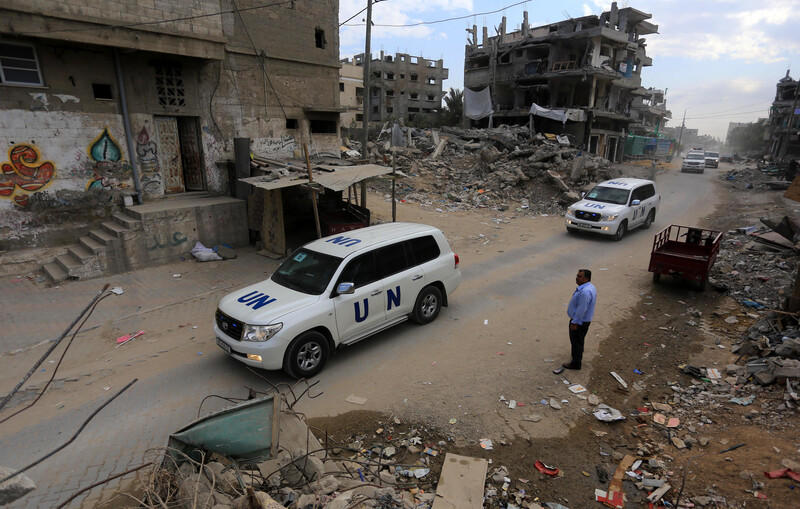
United Nations Secretary General Ban Ki-moon arrives at a UN-run school in Gaza City on 14 October. The UN chief’s visit to the Gaza Strip came a day after a Cairo conference to rebuild the war-ravaged Gaza Strip.
APA images
Smoke rises after a house was blown up by Egyptian forces during a military operation in the Egyptian city of Rafah near the border with the southern Gaza Strip on 29 October. Egypt began setting up a “buffer zone” along the border with Gaza after a suicide bombing perpetrated by unknown actors killed at least thirty soldiers the previous week.
APA images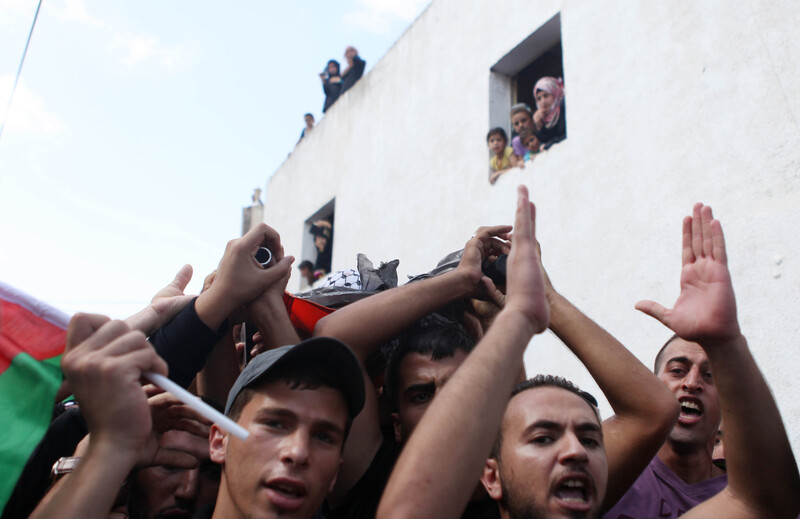
Mourners carry the body of thirteen-year-old Palestinian teenager Bahaa Samir Badir during his funeral procession in the West Bank village of Beit Laqiya on 17 October. The boy died after being shot in the chest by Israeli forces the previous day during clashes after a raid on the village northwest of Ramallah.
APA images
Israeli police stand guard as Jewish settlers stand in a doorway of a home in the Silwan area of occupied East Jerusalem on 21 October. During the night of 19 October, dozens of Israeli settlers accompanied by Israeli forces took control of two residential buildings comprised of ten apartments in the Palestinian neighborhood, according to OCHA, which adds that 25 apartments were taken over in the same area on 30 September.
APA images
Israeli police arrest a Palestinian protester during a 15 October rally outside Jerusalem’s Old City against Israeli-imposed restrictions on access for Muslim worshippers to the al-Aqsa mosque compound. At least four protesters were arrested after Israeli police dispersed the protest. Only Muslim men and women over 50 were allowed to enter the compound in recent weeks as Jewish right-wing activists entered the al-Aqsa mosque compound with police escort.
ActiveStills
Israeli police inspect a wreck in Jerusalem on 22 October after a car slammed into pedestrians at a Jerusalem light railway stop. A baby was immediately killed and a woman later died of her wounds. The driver, a Palestinian from the Silwan neighborhood of eastern occupied Jerusalem, was shot and killed at the scene.
APA images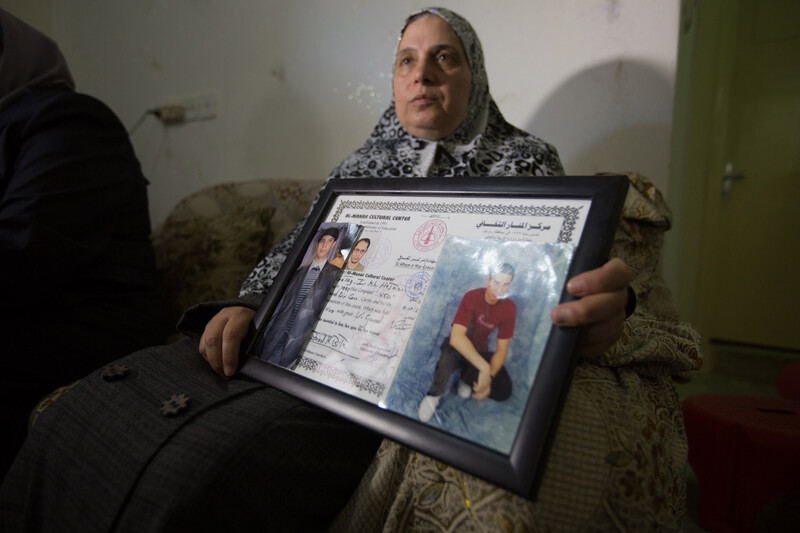
The mother of Mutaz Hijazi holds a photo of her son at their house in the East Jerusalem neighborhood of Abu Tur on 30 October. Israeli police raided the house earlier that day and killed 32-year-old Hijazi, who was suspected of shooting and injuring right-wing provocateur Yehuda Glick the night before.
ActiveStills
Israeli right-wing protesters chant slogans and hold signs calling for revenge during a protest near the tram station in East Jerusalem on 23 October, one day after a Palestinian man ran his car into a crowd there. A baby was immediately killed and a woman later died of her wounds. The driver was shot and killed at the scene.
ActiveStills
Police officers force an African asylum seeker to close her shop on 5 October as residents of south Tel Aviv and right-wing nationalists protest against the Israeli Supreme Court’s decision to cancel the “Infiltrators Law” and to close Holot Detention Center. Residents of south Tel Aviv and right-wing activists protested against migrants, calling on the government to force them out of Israel.
ActiveStills
Relatives of five-year-old Inas Shawkat Khalil mourn during her funeral in the West Bank village of Sinjil, north of Ramallah, on 20 October. The kindergartener was killed after an Israeli settler ran over her and another girl, who remains in a coma, while they were on their way home from school.
APA images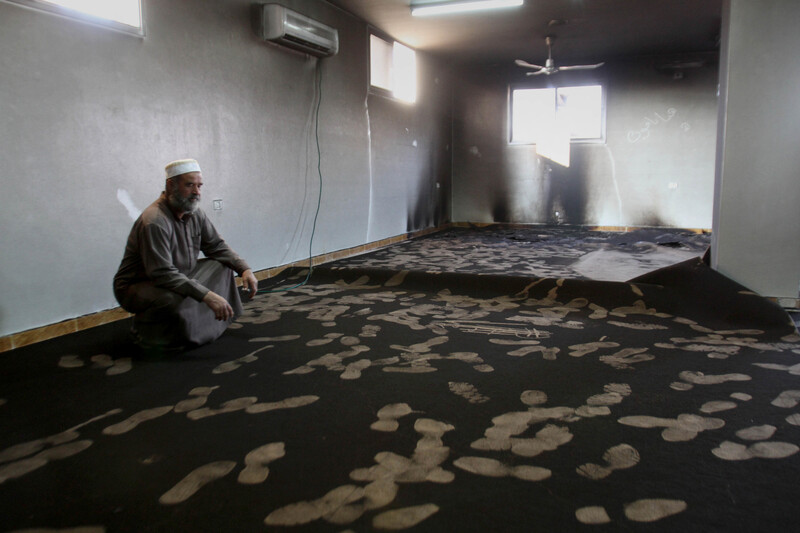
A Palestinian cleric inspects a mosque set on fire by Jewish settlers in the northern West Bank village of Aqraba on 14 October. Hebrew-language graffiti reading “price tag” was spray-painted on the outside wall of the mosque, along with references to the late Meir Kahane, founder of the violent Kach movement.
APA images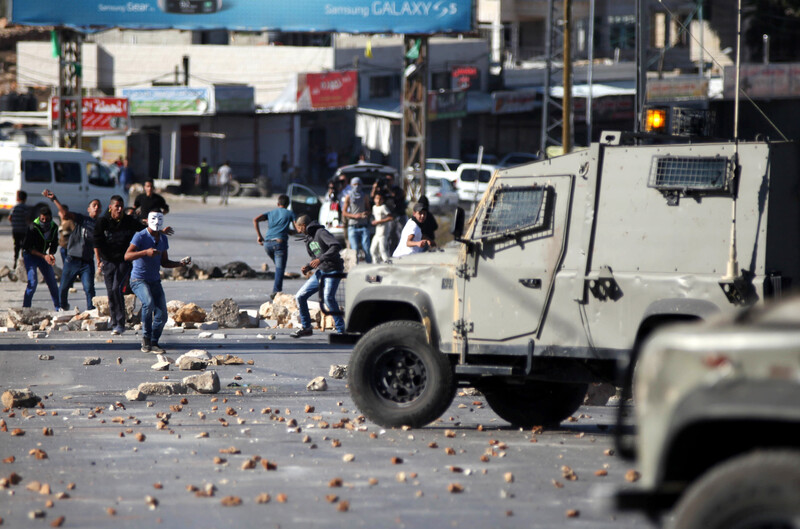
Palestinian protesters throw stones at soldiers during a 24 October demonstration in Jalazone refugee camp near the West Bank town of Ramallah against Israeli restrictions around the al-Aqsa mosque in Jerusalem.
APA images
Palestinian students stand at attention during a graduation ceremony at Al-Istiqlal University in the West Bank city of Jericho on 2 October. A total of 169 security personnel graduated that day from Palestine’s first institution of higher education specialized in security training.
APA images
Employees of the former Palestinian government in the Gaza Strip wait to receive their salaries at a bank in Gaza City on 2 October. Civil servants in Gaza had not been paid for months after the formation of a national unity government in the spring.
APA images
Palestinians take part in a 13 October protest in front of the International Committee of the Red Cross offices in Gaza City demanding the release of their relatives held in Israeli prison.
APA images
A Palestinian woman harvests olives in Salem village, near Nablus in the northern West Bank, on 9 October. Palestinian farmers who have groves behind the nearby Israeli bypass road are allowed to enter their lands twice a year: during olive harvest season and for tilling soil in April. This year, Salem villagers were allowed to work their land for five days only.
ActiveStills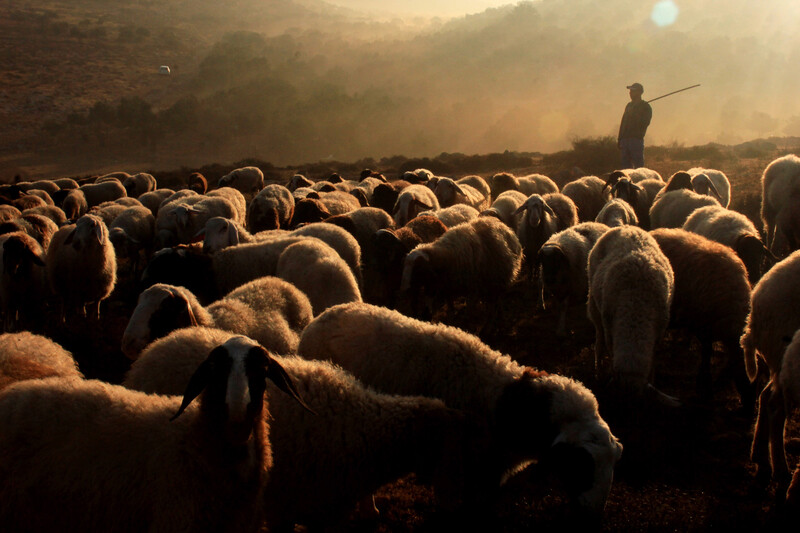
Olive harvest season in Salem village in the northern occupied West Bank, 10 October.
ActiveStills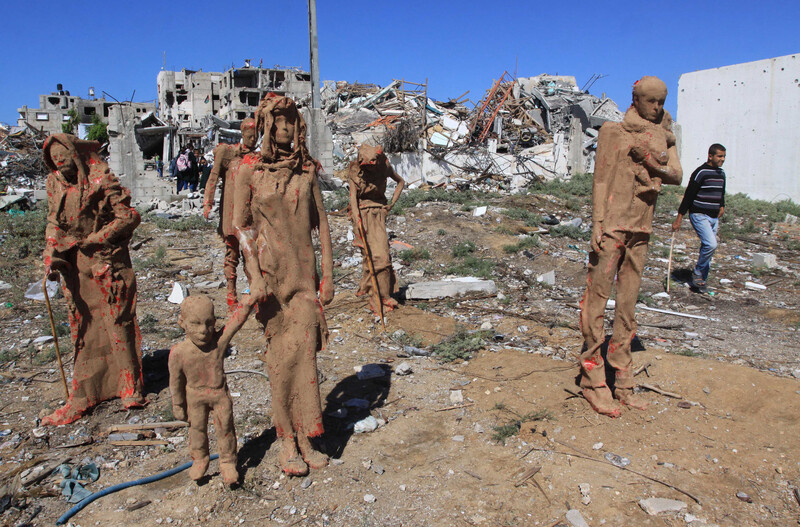
Statues by Palestinian artist Eyad Sabbah stand amidst the rubble of buildings destroyed by Israeli bombardment in the Shujaiya neighborhood of Gaza City on 21 October. The figures, made of fiberglass and covered with clay, depict Palestinians who fled their houses during Israeli shelling this summer.
APA images
A Palestinian worker makes traditional date-filled cookies during the preparation for the Eid al-Adha festival in the West Bank city of Nablus on 2 October. Eid al-Adha, or Feast of the Sacrifice, commemorates God’s provision of a ram to substitute for Abraham’s impending sacrifice of his son.
APA images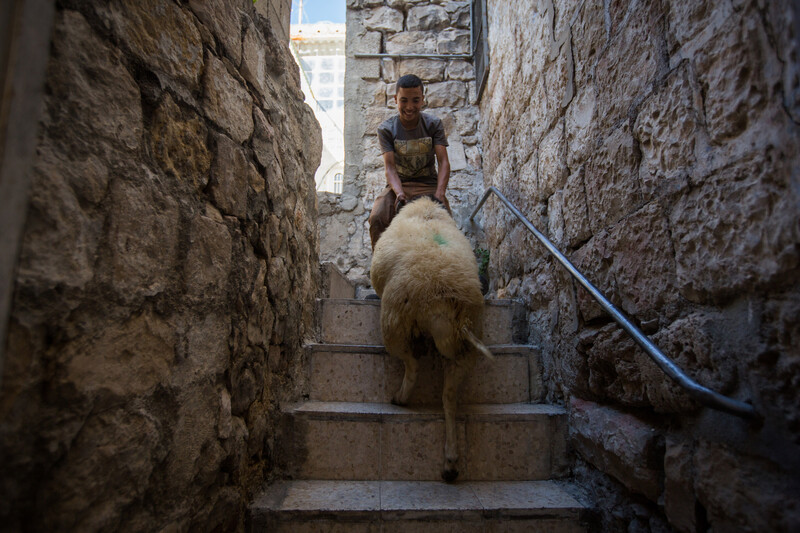
A Palestinian boy pulls a sheep ahead of the Eid al-Adha holiday in Jerusalem’s Old City on 4 October. Israel imposed a security lockdown for the Jewish holiday of Yom Kippur, which is coinciding with the Muslim festival for the first time in three decades. The concurrence of the holy days had not occurred for 33 years because the two faiths follow different lunar calendars.
ActiveStills
A rainbow shines over farmland after heavy rain poured down on Khan Younis in the southern Gaza Strip on 31 October.
APA images

